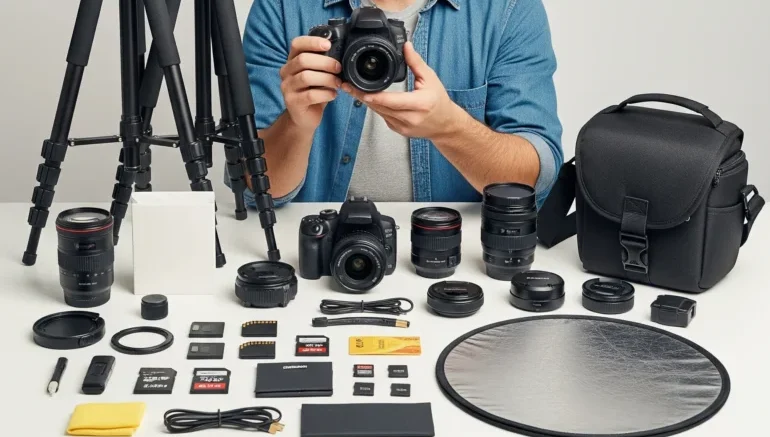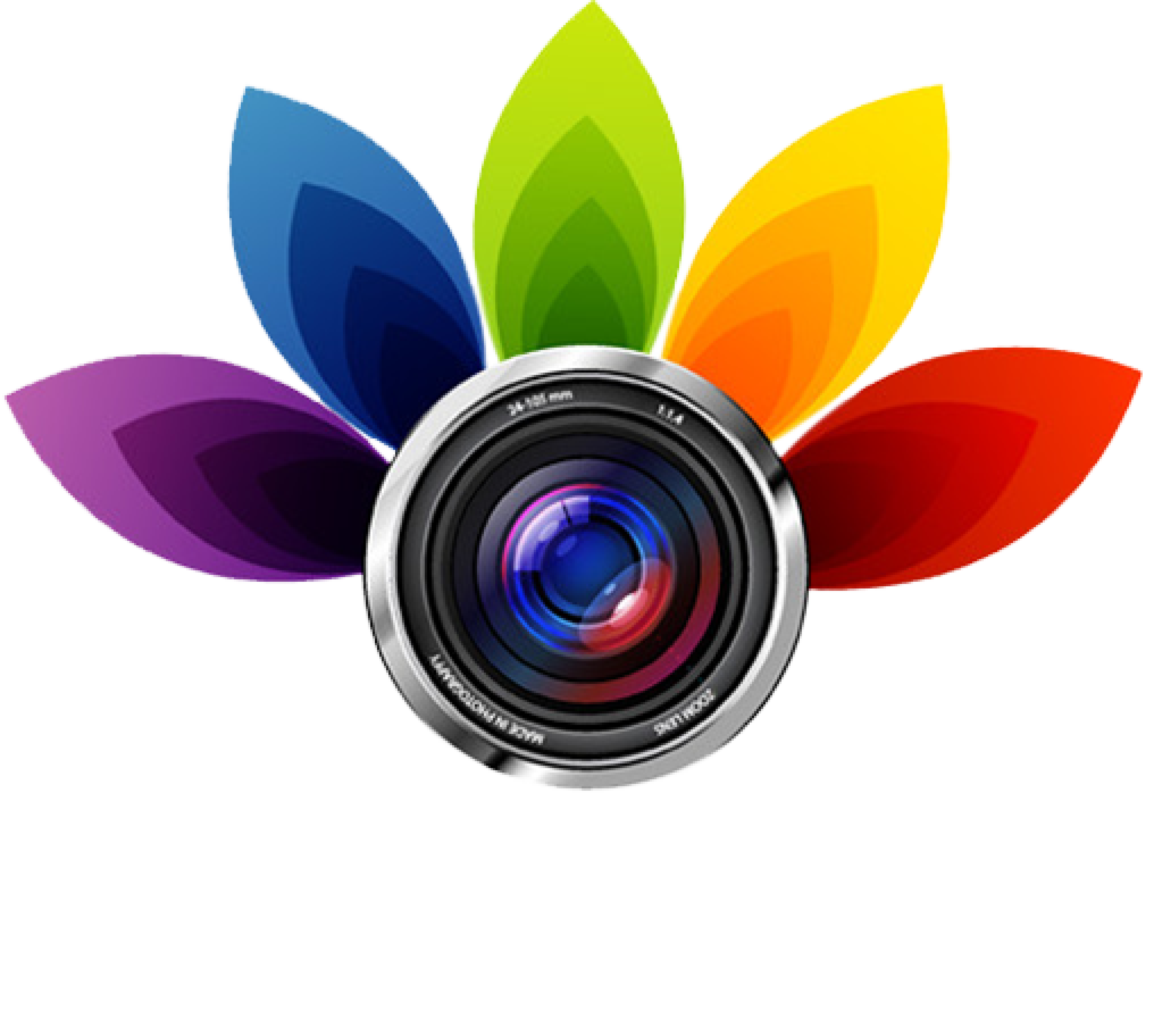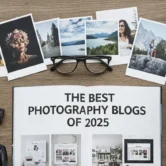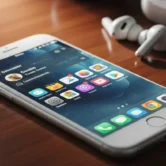
10 Affordable Tools for Beginners to Get Started in Photography
Starting photography can feel exciting and a little overwhelming, especially with all the gear out there. If you’re new to this creative journey, you might be wondering what tools you really need to get started. The good news is, you don’t have to buy everything at once. With just a few smart choices, you can build a simple setup that works well for learning and improving. This guide is here to give you helpful ideas on the gear that makes a real difference when you’re just starting out.
From cameras and tripods to memory cards and cleaning kits, each item on this list has a purpose. We’ve picked tools that are easy to use, budget-friendly, and great for beginners. You don’t need to be an expert to enjoy taking good photos sometimes the right gear is all you need to feel more confident. These gear ideas can help you get better shots, stay organized, and enjoy the process. When you take photos of someone, nature shots, or casual photos, these suggestions will help you start strong in 2025.
Choosing the Right Beginner Gear for Your Photography Style
 Finding a beginner-friendly camera is a big step when you’re just starting out in photography. You don’t need the most advanced or expensive model to take great photos. What matters more is picking a camera that’s easy to use, fits your budget, and matches the kind of photos you want to take. Many beginners start with entry-level DSLRs or mirrorless cameras because they offer good image quality without being too complicated. These cameras often have auto modes that do most of the work for you while you learn the basics.
Finding a beginner-friendly camera is a big step when you’re just starting out in photography. You don’t need the most advanced or expensive model to take great photos. What matters more is picking a camera that’s easy to use, fits your budget, and matches the kind of photos you want to take. Many beginners start with entry-level DSLRs or mirrorless cameras because they offer good image quality without being too complicated. These cameras often have auto modes that do most of the work for you while you learn the basics.
When choosing a camera, think about how and where you’ll use it. If you travel a lot, look for something light and easy to carry. If you love portraits or nature shots, find one that works well in those settings. It also helps to choose a model that lets you change lenses later on, so your gear can grow with your skills.
Here are some simple tips to guide your camera pick:
- Choose a camera with easy menu settings and touchscreen options
- Look for built-in guides or beginner modes to help you learn
- Pick one with Wi-Fi or Bluetooth for easy photo transfers
- Check reviews and sample photos before you buy
- Visit a store, if possible, to test how the camera feels in your hands.
Starting with the right camera makes learning more fun and less stressful.
A Reliable Piece of Gear for Clear and Steady Shots
 A tripod may seem like a basic tool, but it’s one of the most helpful pieces of gear for anyone starting out in photography. It plays a big role in keeping your shots steady and clear especially in low light, long exposure, or when shooting landscapes. Without one, even the slightest hand movement can blur your photo. A reliable tripod keeps your camera in place, so you can focus more on your framing and settings. It’s also useful when you want to be in the photo yourself or explore different angles without holding the camera the whole time.
A tripod may seem like a basic tool, but it’s one of the most helpful pieces of gear for anyone starting out in photography. It plays a big role in keeping your shots steady and clear especially in low light, long exposure, or when shooting landscapes. Without one, even the slightest hand movement can blur your photo. A reliable tripod keeps your camera in place, so you can focus more on your framing and settings. It’s also useful when you want to be in the photo yourself or explore different angles without holding the camera the whole time.
Tripods come in many types, so it helps to find gear that matches your style and routine. Beginners often prefer lightweight and foldable tripods that are easy to carry. Some models even include phone holders, perfect for mobile photography. Just make sure the tripod is strong enough to hold your camera without tipping over.
Here are a few tips to help you choose the right tripod gear:
- Look for a tripod that’s light but sturdy
- Check the height when fully extended and folded
- Choose one with a quick-release plate for fast setup
- Make sure it works well on uneven ground if you shoot outdoors
- If you’re using a phone, get one with a mobile mount
Adding this piece of gear to your kit is a small step that can lead to sharper, more polished photos right from the start.
Backup Power Gear for Smooth Shooting Days
 Running out of battery during a shoot can be frustrating, especially when you’re still learning how to use your gear. Many beginner cameras don’t have long battery life, especially when using the screen often or recording videos. That’s why having extra batteries as part of your photo gear is a smart move. They’re compact, easy to pack, and help you avoid missing good moments. If it’s a short shoot or a full-day session, backup power keeps you going without unnecessary stress.
Running out of battery during a shoot can be frustrating, especially when you’re still learning how to use your gear. Many beginner cameras don’t have long battery life, especially when using the screen often or recording videos. That’s why having extra batteries as part of your photo gear is a smart move. They’re compact, easy to pack, and help you avoid missing good moments. If it’s a short shoot or a full-day session, backup power keeps you going without unnecessary stress.
When choosing spare batteries, make sure they fit your camera model. Some photographers stick to original brand batteries, while others go for trusted third-party gear that fits their budget. Also, remember to charge all batteries before heading out and store them safely. It may seem like a small part of your setup, but it plays a key role in keeping your gear ready throughout the day.
Here are a few tips to get the most out of your battery gear:
- Make sure each battery is fully charged before you leave
- Bring one or two extra batteries for longer shoots
- Store them in a case to prevent damage
- Turn off your camera between shots to save energy
- Keep batteries away from extreme heat or cold
Extra batteries may be a small piece of gear, but they make a big difference when it comes to staying prepared during your photo sessions.
Memory Cards as Important Gear for Smooth Shooting
 Memory cards are one of the most important parts of your photography gear. They store every photo and video you take, making it important to choose the right one especially if you’re just getting used to your gear. A reliable card should have enough space for your needs and fast writing speeds to keep up with your camera. Slow cards can delay saving files or cause your camera to pause, which can interrupt your shoot and slow you down. To avoid those problems, it’s smart to use high-quality memory cards that match your camera’s speed and performance.
Memory cards are one of the most important parts of your photography gear. They store every photo and video you take, making it important to choose the right one especially if you’re just getting used to your gear. A reliable card should have enough space for your needs and fast writing speeds to keep up with your camera. Slow cards can delay saving files or cause your camera to pause, which can interrupt your shoot and slow you down. To avoid those problems, it’s smart to use high-quality memory cards that match your camera’s speed and performance.
Cards with 64GB or 128GB of space are ideal for beginners since they let you shoot more without having to delete files often. As part of your gear setup, it’s also wise to carry a second memory card. It’s easy to fill up space quickly, or misplace a card when switching locations.
Here are some simple tips for getting the most out of your memory card gear:
- Pick a card with fast writing speed (Class 10 or UHS-I is a good start)
- Choose 64GB or higher to give yourself room to shoot freely
- Carry a backup card to stay prepared
- Use a card case to keep your gear protected from dirt or damage
- Format your card in your camera before each shoot for better performance
With the right memory card as part of your photography gear, you can keep your sessions smooth and stress-free, focusing more on taking great shots than on technical delays.
A Basic Lens That Works for Many Scenes
 When you’re new to photography, having a basic lens that works well in different situations is a great starting point. You don’t need to own many lenses right away just one that gives you clear, flexible results. A kit lens, like an 18-55mm, is often included with beginner cameras and is a good all-around option. It can handle portraits, landscapes, and everyday scenes without being too heavy or complex. This helps you practice different styles while learning how to use your camera better.
When you’re new to photography, having a basic lens that works well in different situations is a great starting point. You don’t need to own many lenses right away just one that gives you clear, flexible results. A kit lens, like an 18-55mm, is often included with beginner cameras and is a good all-around option. It can handle portraits, landscapes, and everyday scenes without being too heavy or complex. This helps you practice different styles while learning how to use your camera better.
As you grow more comfortable, you might consider upgrading or adding a second lens, but starting simple is often the best move. A basic lens lets you focus more on your skills instead of worrying about gear. It’s also more affordable, making it easier for beginners to get started. If you’re unsure what lens to choose, look for one that balances quality, ease of use, and versatility.
Here are a few quick tips for choosing and using a basic lens:
- Start with a kit lens (usually 18-55mm) for all-around use
- Choose a lens with image stabilization if possible
- Try a 50mm prime lens later for sharper portraits
- Learn how zoom and focus work before buying more gear
- Keep your lens clean with a soft cloth or cleaning kit.
A basic lens is more useful than it looks it’s a reliable tool that helps you grow your skills without feeling overwhelmed.
The Right Camera Bag to Keep Your Gear Safe and Organized
 A good camera bag does more than just carry your gear it helps keep everything organized and protects your equipment wherever you go. When you’re just starting out, it might be tempting to toss your camera and gear into a regular bag, but that can lead to scratches, damage, or lost accessories. A proper camera bag is designed with padded sections to keep your gear secure and neatly arranged. It also saves time, so you don’t need to dig around for batteries, memory cards, or cables.
A good camera bag does more than just carry your gear it helps keep everything organized and protects your equipment wherever you go. When you’re just starting out, it might be tempting to toss your camera and gear into a regular bag, but that can lead to scratches, damage, or lost accessories. A proper camera bag is designed with padded sections to keep your gear secure and neatly arranged. It also saves time, so you don’t need to dig around for batteries, memory cards, or cables.
Camera bags come in many forms’ backpacks, sling bags, and shoulder bags. The best type depends on how much gear you carry and how you plan to travel. If you’re a beginner, a compact bag is often enough to hold your basic gear without being bulky. And if you shoot outdoors, a weather-resistant bag can protect your equipment from light rain or dust.
Here are a few tips when picking and using a camera bag:
- Choose a padded bag to protect your gear
- Look for compartments to separate camera, lens, and accessories
- Pick a bag that’s easy to carry and fits your lifestyle
- Go for water-resistant or weatherproof material if shooting outside
- Use small pouches inside for memory cards and batteries.
A handy camera bag helps keep your gear safe, easy to reach, and ready for every photo opportunity.
A Simple Cleaning Kit for Clearer Photos
 Keeping your camera gear clean is one of the easiest ways to get clearer and better-looking photos. Dust, fingerprints, and smudges on your lens or sensor can affect image quality and leave unwanted spots in your shots. That’s why having a simple cleaning kit is a smart idea, even for beginners. It helps you keep your camera in top shape and avoid problems during your photo sessions. Cleaning your gear regularly also helps it last longer and saves you from costly repairs later on.
Keeping your camera gear clean is one of the easiest ways to get clearer and better-looking photos. Dust, fingerprints, and smudges on your lens or sensor can affect image quality and leave unwanted spots in your shots. That’s why having a simple cleaning kit is a smart idea, even for beginners. It helps you keep your camera in top shape and avoid problems during your photo sessions. Cleaning your gear regularly also helps it last longer and saves you from costly repairs later on.
A basic cleaning kit doesn’t need to be expensive or complicated. Most kits include a microfiber cloth, lens cleaning solution, air blower, and a soft brush. These tools are gentle on your gear and easy to use. Just remember to clean your lens and camera body gently and avoid using tissues or rough cloths.
Here are a few tips when using your cleaning kit:
- Use a blower first to remove loose dust
- Wipe your lens with a microfiber cloth in small circles
- Never touch the inside of your camera unless you know how
- Clean your gear in a dry, clean place to avoid new dust
- Keep your kit in your bag so it’s always ready.
A simple cleaning kit helps you take clearer shots and keeps your gear ready for your next photo adventure.
A Lightweight Reflector for Better Lighting
 Good lighting can make a big difference in your photos, and a lightweight reflector is one of the simplest tools to help you get it right. Reflectors bounce light onto your subject, helps lessen shadows and bring out hidden details especially when you’re shooting outdoors or near a window. You don’t need fancy lighting equipment to get nice results. With just a foldable reflector, you can improve the light in your photos without spending much money. It’s a great tool for beginners who want to learn how light affects a photo.
Good lighting can make a big difference in your photos, and a lightweight reflector is one of the simplest tools to help you get it right. Reflectors bounce light onto your subject, helps lessen shadows and bring out hidden details especially when you’re shooting outdoors or near a window. You don’t need fancy lighting equipment to get nice results. With just a foldable reflector, you can improve the light in your photos without spending much money. It’s a great tool for beginners who want to learn how light affects a photo.
Reflectors come in different colors like white, silver, and gold, each creating a slightly different effect. White gives soft, natural light; silver helps reflect more light; and gold gives a warm glow. Most beginner kits include all three in one foldable design, which is easy to carry and use. You can have a friend hold it, place it on a stand, or even prop it up against a chair.
Here are some quick tips when using a reflector:
- Use white for soft and balanced lighting
- Use silver to improve lighting in darker areas
- Use gold to add warmth to skin tones
- Angle the reflector to control where the light goes
- Practice with natural light to see what works best.
A reflector is a small tool that gives you more control over light helping your photos look cleaner, more visible, and more professional.
A Mobile Editing App to Improve Your Shots
 Editing your photos doesn’t need a computer or expensive software there are many mobile editing apps that are simple to use and can improve your shots in just a few taps. These apps let you control the lighting levels, fix colors, crop, and sharpen your images right from your phone. For beginners, this is a quick and easy way to learn how editing can make your photos look even better. It’s also perfect for sharing your work on social media or building your photo skills on the go. You can edit anytime, anywhere, without needing extra tools.
Editing your photos doesn’t need a computer or expensive software there are many mobile editing apps that are simple to use and can improve your shots in just a few taps. These apps let you control the lighting levels, fix colors, crop, and sharpen your images right from your phone. For beginners, this is a quick and easy way to learn how editing can make your photos look even better. It’s also perfect for sharing your work on social media or building your photo skills on the go. You can edit anytime, anywhere, without needing extra tools.
Many mobile editing apps are free or very affordable, and they offer plenty of features to get you started. Some apps also have filters and one-tap fixes, which are great if you’re still learning how to edit. Over time, you can explore more advanced tools like curves, masking, or selective editing. Just remember not to overdo it sometimes small edits can make the biggest impact.
Here are some helpful tips when using mobile editing apps:
- Start with free apps like Snapseed or Lightroom Mobile
- Adjust exposure, contrast, and sharpness first
- Use filters lightly to keep photos looking natural
- Save your edits in high quality for better results
- Practice editing different photo styles to learn more.
With a good mobile app and a bit of practice, you can turn simple shots into polished photos you’ll be proud to share.
A Notebook or App for Photo Notes
 Taking notes might not seem important at first, but it can really help you grow as a photographer. A notebook or a photo note app lets you track what settings you used, what went well, and what you want to improve next time. This is useful when you’re practicing with different lighting, angles, or camera features. By writing things down, you’ll start to see patterns in your work and better understand what gives you the results you like. It’s also a great way to keep creative ideas and photo shoot plans in one place.
Taking notes might not seem important at first, but it can really help you grow as a photographer. A notebook or a photo note app lets you track what settings you used, what went well, and what you want to improve next time. This is useful when you’re practicing with different lighting, angles, or camera features. By writing things down, you’ll start to see patterns in your work and better understand what gives you the results you like. It’s also a great way to keep creative ideas and photo shoot plans in one place.
You don’t need anything fancy a small notebook or a simple app on your phone will do the job. The goal is to build a habit of reflecting on your shots and learning from each one. Many photographers note the time of day, weather, location, and camera settings so they can recreate or avoid certain results. Digital apps also let you add sample images or organize your notes by category.
Here are a few suggestions to get started:
- Write down camera settings like ISO, shutter speed, and aperture
- Add location, lighting conditions, and time of day
- Note what you liked or didn’t like about the results
- Use apps like Evernote or Google Keep for quick entries
- Review your notes before your next shoot for better planning
A simple note-taking habit can turn everyday practice into real progress and help you build more confidence behind the camera.
Conclusion
Starting out in photography is more fun when you have gear that actually helps you learn and grow. These 10 tools aren’t just helpful they’re smart choices that can shape how you shoot, edit, and organize from day one. You don’t need to spend a lot or carry a heavy setup to take good photos; you just need gear that fits your needs and makes the process easier. The right setup builds confidence and saves time, which lets you focus more on creating and less on struggling.
Read Next: 10 Tips for Buying Camera Gear That Fits Your Style and Budget





